
Design safe and reliable electronic personal care products
By Prasad Tawade, strategic marketing manager, Littelfuse Inc.
Electronics Engineering Medical Wearable Technology Editor Pick medical switchGlobal health and well-being awareness drive the strong market growth of devices such as electric toothbrushes, electric shavers, epilators, and other innovative products. Electronics, sensors, and battery technology advancements have allowed personal care products to become more intelligent, smaller, and battery-powered. As a result, the personal care electrical appliances market, valued at US$19.6 billion in 2020, is projected to double to $42.5 billion by 2031 with a compound annual growth rate of 7%. The latest innovations will incorporate artificial intelligence technologies, real-time monitoring, data storage, and connectivity for information transfer to mobile devices.
The challenge for designers will be adding advanced features to their new products while minimizing product size and power consumption. In addition, the latest rechargeable Li-ion batteries and fast wireless recharging technologies add to the list of essential design criteria.
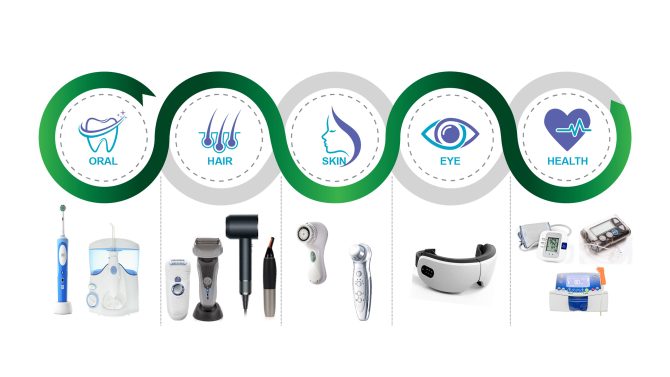
Diversity of personal care and healthcare products with similar electronic architecture. Source: Littelfuse
Furthermore, designers must ensure the safety and reliability of their products. This article provides designers with solutions for making their new products robust to electrical hazards and more efficient for reducing power consumption while enabling them to minimize product size. The article also helps designers reduce the time to market by informing them of the applicable safety standards to which their products must conform to avoid time-consuming, expensive compliance re-testing.
Protection design example: Electric toothbrush
While these recommendations can apply to any personal care and healthcare product, the electric toothbrush will be the product used to illustrate solutions for making a safe, reliable, and efficient design. Figure 2 presents an electric toothbrush showing the main electrical and electronic components. This example uses wireless charging to recharge the battery behind the printed circuit board (pcb).
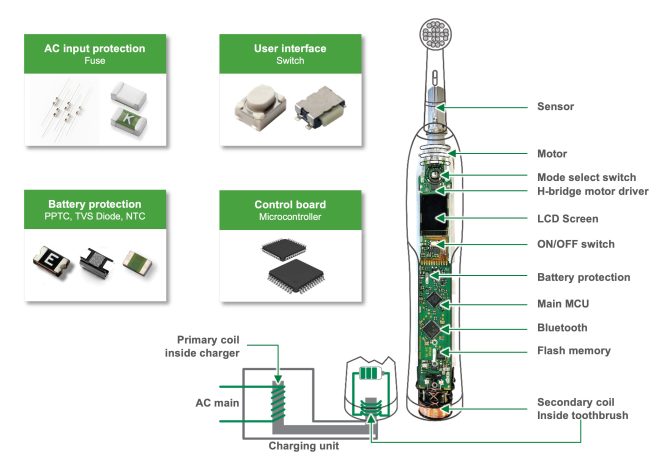
Figure 2. Electric toothbrush and wireless charger. Source: Littelfuse
Protecting from current overloads
Wireless Charger protection
The Wireless Charger interfaces with the AC power line, which has the capacity to deliver a large amount of current. A short in the primary coil inside the charger can cause a significant current overload. A time delay fuse with an appropriate current rating will protect the coil while avoiding nuisance interruptions due to inrush coil current. Ensure the fuse’s voltage rating equals or exceeds the peak line voltage. The fuse should have an interrupting rating exceeding the maximum possible short circuit current so that the fuse will open under the worst-case current overload condition. A small fuse will help to minimize the size of the wireless charger. Of most importance for components connected to the AC line, use a fuse certified to UL/CSA 248, Standard for Low Voltage Fuses.
Battery protection
Ensuring battery safety is critical for designers of personal care products. Protecting the battery from a short circuit or another overload condition requires either a fuse or a polymer positive temperature coefficient (PPTC) resettable fuse. Consider a fast-acting, surface-mount fuse for use in space-constrained personal care healthcare devices when choosing a fuse. Packaging can be as small as an 0603 size. The PPTC fuse option, also available in space-saving, surface mount packaging, avoids fuse replacement requirements after a short circuit or other overcurrent events.
Keeping any voltage transient away from the battery will reduce the risk of battery breakdown due to an overvoltage. Lithium batteries are susceptible to punch-through from a high voltage strike. A transient voltage suppressor (TVS) diode can provide transient protection for the battery. Look for models of TVS diodes with safe absorption of:
- Electrostatic discharge (ESD) strikes as high as 30 kV, either from human contact or through the air (reference IEC 61000-4-2, Electromagnetic compatibility (EMC) testing and measurement techniques),
- Up to 400 W from a peak pulse 10/1000 µs waveform, and
- Up to 60 A of peak surge current.
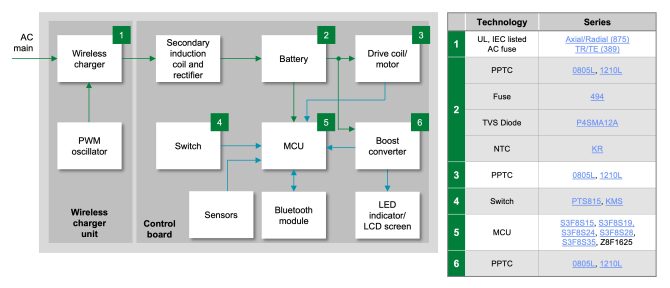
Electric toothbrush’s block diagram and the recommended components for protection and efficiency. The adjacent table lists the component types recommended for protecting the product (and the user) while maximizing product efficiency. Source: Littelfuse
TVS diodes respond to a transient in an extremely fast time of under 1 ps. They are also available in uni-directional or bi-directional models. Also, surface mount models are available. Figure 4 shows schematics of the bi-directional and uni-directional models and illustrates how a TVS diode responds to a voltage transient by clamping the peak voltage. Select a TVS diode with a version whose clamping voltage is sufficiently low to avoid damage to the battery.
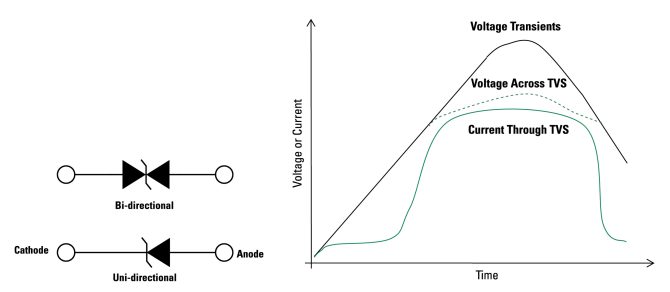
Figure 4. Two types of TVS diodes and a plot illustrating their response to a voltage transient. Source: Littelfuse
Monitoring battery temperature is another critical function for ensuring a safe device. A negative temperature coefficient element, a thermistor, with a temperature measurement range of -40 to +125°C, can monitor battery temperature. Miniature surface mount versions facilitate contact with the battery to ensure battery-effective heat transfer to the thermistor. The microcontroller unit (MCU) can monitor the battery temperature and shut down operation if the thermistor detects a fast temperature rise.
Drive coil/motor and boost converter protection
The Drive Coil/Motor circuit powers the spinning brushes, and the Boost Converter increases the voltage to drive the LED power-on indicator and the LCD screen. Consider using a resettable, surface-mount PPTC fuse for these two circuits. In the Drive Coil/Motor circuit, the fuse will protect the power MOSFETs from a short in the motor windings. In the Boost Converter, the fuse will protect the circuit and the LCD screen from potential startup inrush current damage. PPTC fuses will enhance the reliability of both these circuits.
Efficiently controlling the electronic toothbrush
The Switch controls the power to the electric toothbrush, chooses the operating function, and selects the brush speed. Look for long-life switches with ratings of at least 50,000 and preferably 100,000 operations. Space-saving surface mount versions are available with reliable and repeatable haptic performance.
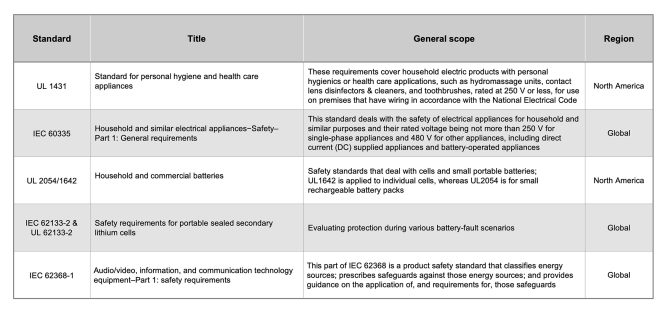
Table 1. Standards applicable to personal care and healthcare electronic products. Source: Littelfuse
The MCU controls the operation of the electric toothbrush. Select a low-power microcontroller to maximize the length of the battery discharge cycle. Models that operate at voltages as low as 1.8 V and at low speeds, such as 0.5 MHz to minimize power consumption are available. Typically, 8-bit or 16-bit microcontrollers provide acceptable performance for a product like an electric toothbrush. Look for an MCU with ESD resistance and a low power idle mode, like the ZILOG S3 family of microcontrollers. Since a battery powers the MCU, consider models with a low voltage detection mode for safe, controlled shutdown of the toothbrush when the battery voltage reaches a low voltage threshold level. Selecting a small MCU is essential for achieving product size objectives.
Applicable safety standards
Since personal care and healthcare products interface with human beings, the product will require compliance to appropriate safety standards. Table 1 lists the applicable standards and describes their scope and the region where the standard applies. Designers should include compliance standards in their project design goals. Not adhering to the requirements of the standards can result in late-stage re-design and multiple re-test cycles for compliance certification, resulting in unplanned increases in development costs and delays in product introduction.
Use of a few components provides product protection and efficiency
Designers can provide product protection and optimize their product’s efficiency with a small number of components. Furthermore, designers can save development time and reduce the time to market by taking advantage of the component manufacturer’s expertise. Component manufacturers can assist with:
- Cost-effective component selection
- Safety standard compliance
- Pre-compliance testing (offered by some manufacturers).
- Familiarizing with and using the recommended components and techniques will enable the design of a robust, small, low-power consumption product.
